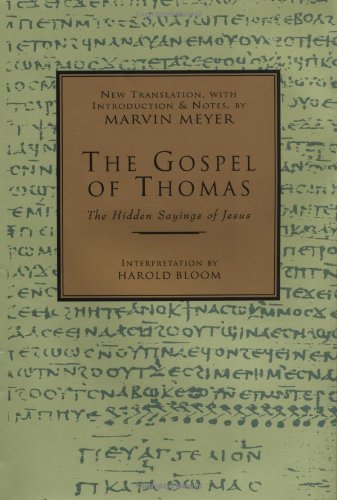
A fresh, authoritative English translation, with an informative introduction, fascinating explanatory notes, and the Coptic text, with interpretation by Harold Bloom, our pre–eminent literary critic.
The gospel according to Thomas is an ancient collection of sayings attributed to Jesus and thought to be recorded by his brother Judas, the Twin (Thomas means “twin” in Aramaic). Some scholars suggest that this gospel was collected from New Testament sayings, while others believe it springs from a completely independent author because many of the quotations are not in the New Testament at all. It slept for two millennia in a stone jar until it was accidentally exhumed by a group of fertilizer gatherers in the northern Egyptian desert in 1945. (The gospel is just one document in the fourth-century papyrus library discovered near the city of Nag Hammadi, from which the entire collection gets its name.) Marvin Meyer’s distinguished translation includes Coptic text on each left page and the English translation on the right. It is considered by many to be perhaps the closest we’ll ever get to reading what was actually said by the historical Jesus. In The Gospel of Thomas, you’ll discover a different kind of Christ–a wandering spiritual teacher from Galilee who performs no miracles, reveals little prophecy, announces no apocalypse, and dies for no one’s sins. –P. Randall Cohan

114 Sayings attributed by the Gnostic Christians to Jesus In 1945 a couple of Egyptians digging in the Nile River valley found a sealed storage jar that contained a collection of fifty-two ancient manuscripts, most of which were devoted to the teachings of Gnosticism, early Christians who believed that matter is evil and that emancipation comes through “gnosis” (the Greek word for “knowledge”). The Gnostic inner quest for spiritual understanding put them at odds with the authority of the Church in the first, formative centuries of Christianity. It is not surprising that the Gnostic writings were suppressed by the early Church and were really only known to us through the writings of their opponents. The discovery of these manuscripts allows us to read what these early Christians were thinking and to judge for ourselves the value of their beliefs.
The book is fine I have used this book as a study with my congregation and the members of the class found it both engaging and helpful. While not a ‘traditional’ gospel in the manner of Matthew, Mark, Luke and John, it is a unique, though not entirely foreign, look at the sayings of Jesus.
An Excellent Introduction To An Important Christian Text The first verse of the Gospel of Thomas tells the reader that whoever understands the gospel’s sayings will not “…taste death.” It is a clear message that understanding these sayings of Jesus is key to one’s spiritual growth. Thus, the onus is on the interpreter to create both an effective translation and a context to evaluate the sayings in order to facilitate this growth. Meyer does a marvelous job of meeting these demands.